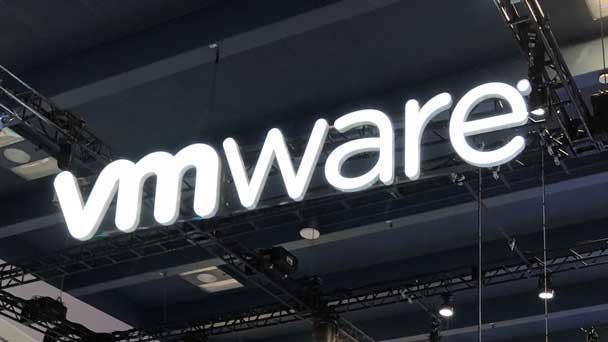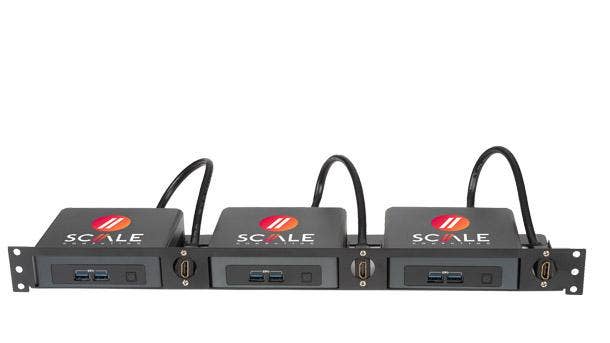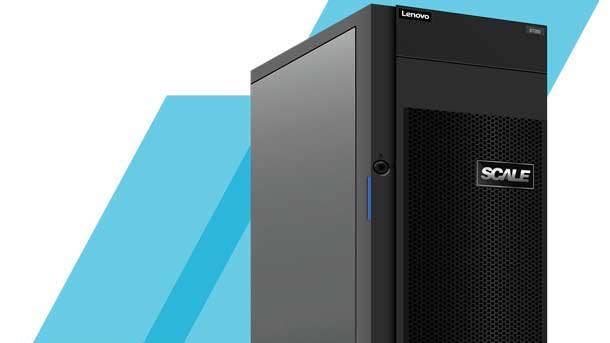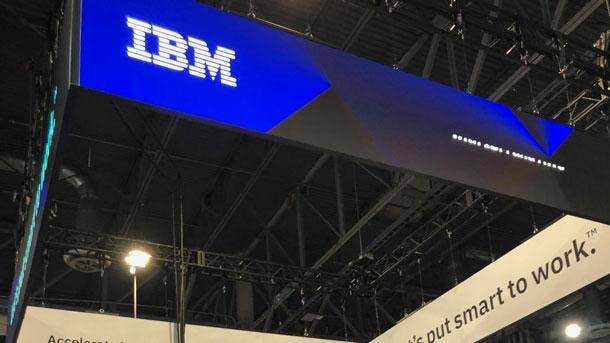70 Percent Of Scale Computing Clients Come From VMware: CEO Jeff Ready
“When you look at the data from that VMware survey, you see customers validating what we’ve been telling them for ten years, which is, ‘Hey, when you make the move to Scale, it’s going to change your life,’” said Scale Computing CEO Jeff Ready.

Jeff Ready To VMware Customers: Scale Computing Is ‘Going To Change Your Life’
Scale Computing’s CEO Jeff Ready says VMware midmarket customers and businesses seeking optimized edge computing solutions are turning to Scale Computing in droves.
The Indianapolis, Ind.-based hyperconverged infrastructure and edge computing specialist recently conducted a survey in partnership with Spiceworks of 250 current and previous VMware customers across more than 20 industries.
“When you look at the data from that VMware survey, you see customers validating what we’ve been telling them for 10 years, which is, ‘Hey, when you make the move to Scale, it’s going to change your life,’” said Ready, CEO and co-founder of Scale Computing in an interview with CRN. “Really, that is what it does. It’s not just going to save you some money, it completely changes the way that the infrastructure behaves and how you manage it.”
According to the survey of previous and current VMware end users, around 50 percent reported that they were not fully utilizing the technology’s available capabilities, which Scale Computing suggests shows the complexity of VMware may exceed the needs of its customers.
VMware declined to comment on the matter.
Other survey highlights seeking to prove Scale Computing’s market differentiation include respondents reporting that 85 percent of VMware deployments suffer annually from downtime events, including 25 percent experiencing downtime exceeding 24 hours in the last 12 months. Additionally, enterprise IT administrators spent 16 hours per week on routine maintenance tasks like patching. By comparison, a typical Scale Computing customer reduces on-going management costs by 60 percent to 80 percent due to the automation and machine learning capabilities in Scale’s HC3 solutions, according to Ready.
“I ask [VMware customers], ‘How much money have you lost?’ Or, ‘How much extra energy have you expended because you didn’t make the switch five years ago?’ It starts to pile up,” said Ready, who told CRN that roughly 70 percent of customers came to Scale Computing directly from VMware. “You see customers saying things like Scale saves them 70 percent, 80 percent, or their recovery time from failures goes down by 95 percent. You’re one failure away from the whole thing paying for itself.”
In an interview with CRN, Ready talks about competition with VMware, Scale Computing’s new partnership with IBM and the company’s biggest investments and opportunities in edge computing.

You say 70 percent of Scale Computing’s customers came directly from VMware. Why?
The question is, ‘Well, why are they looking for VMware alternatives?’ And that comes around to ‘Well, VMware is expensive.’ Expensive is sort of a generic term, but it’s expensive because when you’re only using 20 percent or 30 perfect of the features -- well, of course it’s expensive. You’re paying for 100 percent of the features but using 30 percent. That doesn’t seem right. And then there’s these other challenges.
Where Scale initially gained traction is -- and we embraced this wholeheartedly -- was among mid-market companies. That’s who initially was attracted to Scale. When you think about that mid-market customer, they stereotypically have smaller IT departments, less specialization within those IT departments, and when you look at our core strength in things like manufacturing and education, very often mid-market customers are managing multiple sites with a relatively small IT team.
Many of those elements now sound sort of in the direction of edge computing. The back of the grocery store has no IT people. Without realizing it at the time, the reason we were getting all these mid-market customers was because of the ease of use and our total value relative to what they needed of the solution. As edge computing has sort of come onto the scene, what’s happened is Scale now has much, much larger customers, Fortune 500 companies and so forth, when they’re deploying an edge-type environment. Which looks a lot like that local K-12 environment than the traditional data center.

Can you double down on why you say Scale Computing has a leg-up over VMware in the growing edge computing space?
The edge is not the data center. If you’re going to stand up a traditional regional data center and have 13 racks of gear across a couple of floors -- yeah, you’re probably running VMware. I mean, that’s just the standard.
It’s almost like when you think about horizontal scalability versus vertical scalability, meaning, it’s not that I’m running 13 racks of gear in one location, it’s that I’m now running three or five node servers in 1,500 locations. It’s a different kind of problem. It’s not all top-of-rack switching -- that doesn’t matter if I’ve got three nodes in the back of a restaurant. But if I have 1,000 restaurants, I have a whole different management challenge. So we’re seeing that customers who were trying to use tools like VMware in these different kinds of environments are coming to Scale.
When you look at that survey data, you’ll see, ‘Okay, we bought VMware, but we’re only using 20 percent of the feature set.’ To me, this is kind of what you’d expect if you’re trying to use a tool that was built for one environment and move it into another. There’s something there that you want, but there’s a whole bunch of stuff that you’re not going to use. And because you’re not using it, then it becomes more complicated. And not just complicated in terms of stuff like setup and management, but this concept of, frankly, break-fix. So, something goes wrong, and now you’ve got a broken VMware environment in the back of a grocery store, and an IT guy – who’s maybe not even in the same country – is trying to talk the store manager through it. It’s a mess, right? It doesn’t make any sense. And that’s where these things sort of fall down and where Scale has been pretty good at.

Say I’m a VMware channel partner who’s never partnered with Scale before, why is 2021 the time to do it?
Channel partners’ number one job is to show your customers the future roadmap. If I’m a channel partner, the way that I ensure success with that customer is I do something that basically keeps their operation running smooth for the next 20 years. We are at a moment where that is changing. So, if you’re the one selling the legacy tools into the new environment, you risk losing that customer to somebody who’s taking them into the future.
So it’s not like you have to pick Scale and drop VMware, right? That not the case. Those customers that are running in the data center and they want to keep running VMware, more power to them. But as they’re looking to deploy more at the edge or if they’re a classic mid-market type customer who doesn’t have the needs of a centralized enterprise in the data center -- then something like Scale is an interesting option for them.
We are getting feedback from the channel that says, ‘Yes. When we’re looking at edge and we’re looking at hyperconvergence, you’re our pick.’ Partners can reassure the customer, ‘You, Mr. Customer, don’t know Scale, but I know Scale.’ And that’s why our channel partnerships and relationships are working.
What if I’m a VMware customer who’s never looked at Scale before?
A customer could say the same thing. ‘I’m a VMware shop. Why would I look at something else?’ When you look at the data from that VMware survey, you see customers validating what we’ve been telling them for 10 years, which is, ‘Hey, when you make the move to Scale, it’s going to change your life. Really, that is what it does. It’s not just going to save you some money, it completely changes the way that the infrastructure behaves and how you manage it.’
I ask [VMware customers], ‘How much money have you lost?’ Or, ‘How much extra energy have you expended because you didn’t make the switch five years ago?’ It starts to pile up. You see customers saying things like, Scale saves them 70 percent, 80 percent, or their recovery time from failures goes down by 95 percent. You’re one failure away from the whole thing paying for itself.

Talk about your recently formed partnership with IBM and why it’s important?
One of the interesting technology innovations is there’s a tool that needs to find exactly how it’s going to be used -- and that’s the use of containers and Kubernetes. A lot of it can make sense for the edge. On the other hand, in an oil tanker for example, it’s offline 80 percent of the time. So, cloud-controlled Kubernetes doesn’t work on oil tankers. So you need a platform which is autonomous like Scale, but then there are moments where you want to use container management systems.
We support containers already on Scale, but what the IBM partnership brings to the table is deep integration with a solution called IBM Edge Application Manager (IEAM). It’s basically IBM’s control plane for containers. For the future of this hybrid, cloud and edge world, when you’re deploying an application through something like IEAM such as a new ERP system.
Visually we say, ‘Here’s a drop-down box for everywhere you can deploy that.’ And it might say ‘AWS’ or ‘Google’ but you can also get a whole list of all of the on-prem Scale instances you have. To the IT professional, deploying on Scale and deploying in Amazon feels exactly the same, which is cool. They don’t need to think about, ‘How do I manage one system versus another?’ They just deploy the application where it needs to be.
We’re seeing the need or the desire for a lot of companies to embrace containerization for applications. At the same time, probably universally, those same customers have all kinds of existing applications or legacy applications that are not containerized. So they need one platform that can run everything. Because the last thing you’re going to do at the edge is start deploying multiple instances. It’s already a pain to go manage it. So I’m not going to have one environment to run virtual machines, and one environment to run containers, and some other environments for the cameras, etc. -- it’s way too much. The back of a grocery store would need an entire data center in it. That wouldn’t work. … Also, IBM has a whole suite of applications containerized for retailers. Then Scale becomes a natural platform for how they might deploy that.

Scale Computing is a pioneer in edge computing. As a trusted expert, what’s your view of the edge in 2021?
What we’re seeing is that the kinds of technologies, tools and products that we’re bringing to the table are built for this edge computing environment. The edge rose up to meet us. We were doing this stuff before it was sort of called edge.
We do a lot in manufacturing, which stereotypically still does a lot of on-premises compute. They didn’t use data centers to the same extent that most industries did. Certainly, they used some, but a lot of manufacturers have stuff physically in the building like an old server room. We’re seeing that these guys in manufacturing are now not only deploying in those on-prem, server rooms, but they’re deploying infrastructure on the factory floor. And it might be very specialized like just collecting data or running video cameras or just analyzing something.
The tools that we built to run on-premises now apply very well to the edge. So as the edge becomes this new wave -- and I suspect probably a new wave that will be here for a long time for lots of technical reasons, lots of practical reasons -- I envision that the next 20 years of computing is really a hybrid, edge and cloud story. That’s where things are going. You’re going to run applications wherever they make the most sense. Some of those applications will run on-prem, some are going to run in the cloud, some may move back and forth -- and you need the tools that are going to manage all of that, which is what we’re offering.

You’ve recently formed distribution agreements overseas with Softpi and KSG. What’s Scale’s goal here?
One of the offshoots of the rise of edge is that we’re deploying with larger companies. And those larger companies will very often have an international presence. So, for example, oil tankers, you got a fleet of 100 oil tankers that are everywhere and operate out of all kinds of different ports globally. I need the ability to sell into those environments. So that mandates that we start to look more globally than we traditionally have been. So partnerships with KSG in Japan, for example, are one of those things.
The first step in that direction was when we started to have some OEM partnerships with the likes of Lenovo and so forth. But now we’ve got more direct partnerships in the field and that’s been exciting.
Scale Computing was 90 percent North American-based three or four years ago and now that’s changing quite a bit. I expect that to continue because the edge is sort of what’s pulling us in that direction.

What’s a big new investment Scale is doing to drive net-new edge computing sales?
We’ve made some announcements in the video surveillance and security space. We found that digital video, which generally means surveillance, is one of the primary edge use cases. There’s lots of edge computing use cases, but it’s one where even a small type of customer typically is doing something with video. We see surveillance is sort of universal, but we see digital video in manufacturing starting to be widely deployed where they’re using analytics tools to look at parts coming down the line and inspecting it for flaws, or different things that mechanical engineers do like collecting data, processing data, making decisions on that data, literally, right on the factory floor. They might be using AI and different things, but us providing that platform has been good.
We’ve seen some good traction with video, but some of the interesting things -- especially in regards to the channel is – you’ve got this convergence of traditional video integrators. So, people that would come into a customer to do security cameras, building controls, and key FOBs, and all this kind of stuff, which is not IT.
Yet they’re putting in a video surveillance system, so there’s software applications that are collecting data, there’s different applications that are processing that data and they may have three or four different apps running on a server just to do video. Then building controls is another server and the thing that runs the gate at the plant is another server. So they find themselves needing something like hyper-converged infrastructure at the edge.
We’re seeing this interesting kind of crossover in the channel where traditional IT vendors are now moving into video systems, and traditional video vendors are moving into IT systems. We’re basically setting them up with a platform that can start on either end, or both at the same time, and kind of merge into the other.